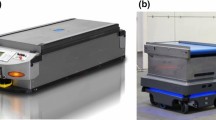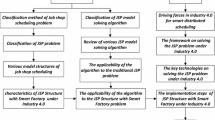Abstract
This paper focuses on the scheduling problem of the reconfiguration manufacturing system (RMS) for execution level, where the final objective is to output a production plan. The practical situation in Chinese factory is analyzed, and the characteristics are summarized into the contradiction between flow and job shop production. In order to handle this problem, a new production planning algorithm in virtual cells is proposed for RMS using an improved genetic algorithm. The advantages of this algorithm have three parts: (1) the virtual cell reconfiguration is formed to assist making production plans through providing relationship among task families and machines from cell formation; (2) The operation buffer algorithm is developed for flow style production in cells, which can realize the nonstop processing for flow style jobs; and (3) The multicell sharing method is proposed to schedule job shop jobs in order to fully utilize manufacturing capability among machines in multicells. Based on the above advantages, an improved genetic algorithm is developed to output scheduling plan. At last, the algorithm is tested in different instances with LINGO and the other genetic algorithm, and then the scheduling solution comparison shows the proposed algorithm can get a better optimum result with the same time using the comparison algorithm.
Similar content being viewed by others
References
Koren Y (2006) General RMS characteristics. Comparison with dedicated and flexible systems. Chapter 3 in the reconfigurable manufacturing systems and transformable factories. Springer, Netherlands
Deljoo V, Mirzapour Al-e-hashem SMJ (2010) Using genetic algorithm to solve dynamic cell formation problem [J] .Appl Math Model 1078–1092
Chen M (1998) A mathematical programming model for systems reconfiguration in a dynamic cell formation condition. Ann Oper Res 77(1):109–128
Ahkioon S, Bulgak AA, Bektas T (2007) Cell manufacturing systems design with routing flexibility, machine procurement, production planning and dynamic system reconfiguration. Int J Prod Res. doi:10.1080/00207540701581809
Abbasi M, Houshmand M (2008) Production planning and performance optimization of reconfigurable manufacturing systems using genetic algorithm [J]. Int J Prod Res 46(16):459724617
Jae-Min Y, Doh H-H (2013) Input sequencing and scheduling for a reconfigurable manufacturing system with a limited number of fixtures. Int J Manuf Technol Manag 67:155–169
Kim H-W, Yu J-M, Kim J-S, Doh H-H, Lee D-H, Nam S-H (2012) Loading algorithms for flexible manufacturing systems with partially grouped unrelated machines and additional tooling constraints. Int J Adv Manuf Technol 58:683–691
Sreedhar K, Veerana V, Prasad D, Sarma Dattatraya B (2010) Optimization of FMS scheduling using non-traditional techniques. Int J Eng Sci Technol 2:7289–7296
Hegui Ye (2006) Simultaneous modular product scheduling and manufacturing cell reconfiguration using a genetic algorithm. Trans ASME 128
Rezazadeh H, Mahini R, Zarei M (2011) Solving a dynamic virtual cell formation problem by linear programming embedded particle swarm optimization algorithm. Appl Soft Comput 11:3160–3169
Mak and Wang (2009) Development and integration of a reactive real-time decision support system in the aluminum industry [J]. Eng Appl Artif Intell 897–905
Mak and Wang (2005) Parallel-machine rescheduling with machine disruptions [J]. IIE Trans 1113–1118
Irani (2004) Dynamic rescheduling that simultaneously considers efficiency and stability [J]. Comput Ind Eng 46:1–15
Saad SM, Baykasoglu A, Gindy NNZ (2002) An integrated framework for recon-figuration of cell manufacturing systems using virtual cells. Prod Plan Control 13(4):381–393
Slomp J, Chowdary BV, Suresh NC (2005) Design of virtual manufacturing cells: a mathematical programming approach. Robot Comput Integr Manuf 21(3):273–288
Slomp J, Chowdary BV, Suresh NC (2004) Design and operation of virtual manufacturing cells, Proceedings of FAIM Conference, Tampa, FL
Ratchev SM (2001) Concurrent process and facility prototyping for formation of virtual manufacturing cells. Integr Manuf Syst 306–315
Gen M (2000) Cheng R Genetic algorithms and engineering optimizations. Wiley, New York
Tay JC, Wibowo D (2004) An effective chromosome representation for evolving flexible job shop schedules. GECCO. In: Lecture Notes in Computer Science, vol. 3103. Springer, Berlin 210 –211
Ye H, Liang M (2006) Simultaneous modular product scheduling and manufacturing cell reconfiguration using a genetic algorithm. J Manuf Sci Eng 128:984–995
Author information
Authors and Affiliations
Corresponding author
Additional information
This project is supported by National Natural Science Foundation of China (51175045).
Rights and permissions
About this article
Cite this article
Li, J., Wang, A. & Tang, C. Production planning in virtual cell of reconfiguration manufacturing system using genetic algorithm. Int J Adv Manuf Technol 74, 47–64 (2014). https://doi.org/10.1007/s00170-014-5987-0
Received:
Accepted:
Published:
Issue Date:
DOI: https://doi.org/10.1007/s00170-014-5987-0




